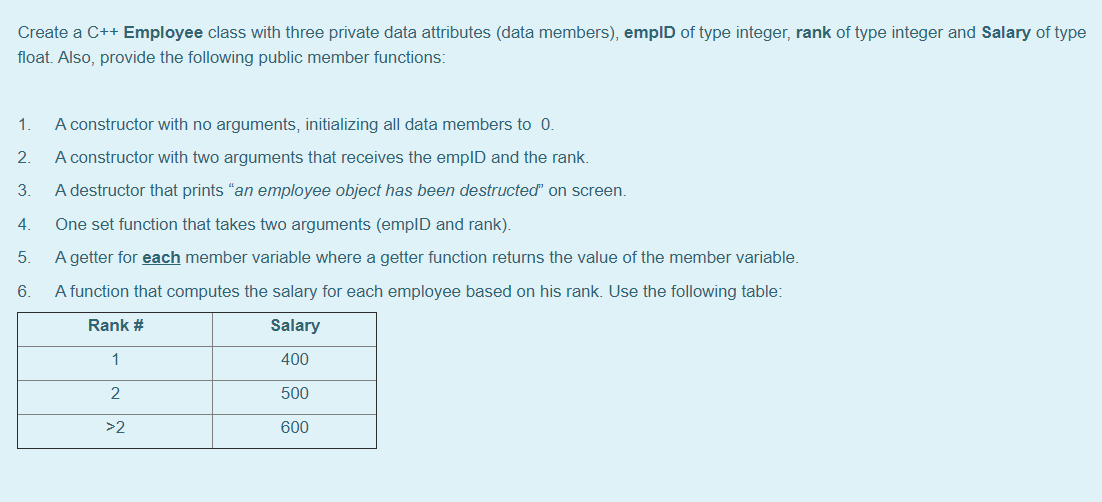Create a C++ Employee class with three private data attributes (data members), emplD of type integer, rank of type integer and Salary of type float. Also, provide the following public member functions: 1. A constructor with no arguments, initializing all data members to 0. 2. A constructor with two arguments that receives the emplID and the rank. 3. A destructor that prints "an employee object has been destructed" on screen. 4. One set function that takes two arguments (emplID and rank). 5. A getter for each member variable where a getter function returns the value of the member variable. 6. A function that computes the salary for each employee based on his rank. Use the following table: Rank # Salary 1 400 2 500 >2 600
Create a C++ Employee class with three private data attributes (data members), emplD of type integer, rank of type integer and Salary of type float. Also, provide the following public member functions: 1. A constructor with no arguments, initializing all data members to 0. 2. A constructor with two arguments that receives the emplID and the rank. 3. A destructor that prints "an employee object has been destructed" on screen. 4. One set function that takes two arguments (emplID and rank). 5. A getter for each member variable where a getter function returns the value of the member variable. 6. A function that computes the salary for each employee based on his rank. Use the following table: Rank # Salary 1 400 2 500 >2 600
Computer Networking: A Top-Down Approach (7th Edition)
7th Edition
ISBN:9780133594140
Author:James Kurose, Keith Ross
Publisher:James Kurose, Keith Ross
Chapter1: Computer Networks And The Internet
Section: Chapter Questions
Problem R1RQ: What is the difference between a host and an end system? List several different types of end...
Related questions
Question
c++

Transcribed Image Text:Create a C++ Employee class with three private data attributes (data members), emplD of type integer, rank of type integer and Salary of type
float. Also, provide the following public member functions:
1.
A constructor with no arguments, initializing all data members to 0.
2.
A constructor with two arguments that receives the emplD and the rank.
3.
A destructor that prints "an employee object has been destructed" on screen.
4.
One set function that takes two arguments (emplD and rank).
5.
A getter for each member variable where a getter function returns the value of the member variable.
6.
A function that computes the salary for each employee based on his rank. Use the following table:
Rank #
Salary
1
400
2
500
>2
600
Expert Solution
This question has been solved!
Explore an expertly crafted, step-by-step solution for a thorough understanding of key concepts.
Step by step
Solved in 4 steps with 4 images

Recommended textbooks for you

Computer Networking: A Top-Down Approach (7th Edi…
Computer Engineering
ISBN:
9780133594140
Author:
James Kurose, Keith Ross
Publisher:
PEARSON

Computer Organization and Design MIPS Edition, Fi…
Computer Engineering
ISBN:
9780124077263
Author:
David A. Patterson, John L. Hennessy
Publisher:
Elsevier Science

Network+ Guide to Networks (MindTap Course List)
Computer Engineering
ISBN:
9781337569330
Author:
Jill West, Tamara Dean, Jean Andrews
Publisher:
Cengage Learning

Computer Networking: A Top-Down Approach (7th Edi…
Computer Engineering
ISBN:
9780133594140
Author:
James Kurose, Keith Ross
Publisher:
PEARSON

Computer Organization and Design MIPS Edition, Fi…
Computer Engineering
ISBN:
9780124077263
Author:
David A. Patterson, John L. Hennessy
Publisher:
Elsevier Science

Network+ Guide to Networks (MindTap Course List)
Computer Engineering
ISBN:
9781337569330
Author:
Jill West, Tamara Dean, Jean Andrews
Publisher:
Cengage Learning

Concepts of Database Management
Computer Engineering
ISBN:
9781337093422
Author:
Joy L. Starks, Philip J. Pratt, Mary Z. Last
Publisher:
Cengage Learning

Prelude to Programming
Computer Engineering
ISBN:
9780133750423
Author:
VENIT, Stewart
Publisher:
Pearson Education

Sc Business Data Communications and Networking, T…
Computer Engineering
ISBN:
9781119368830
Author:
FITZGERALD
Publisher:
WILEY